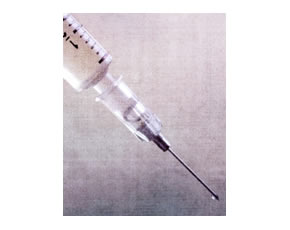
Treatment with rituximab, a monoclonal antibody targeting CD20+ B cells, could adversely affect immunization responses by dampening the antibody response from new vaccination or reducing pre-formed antibody from prior vaccination. However, little systematic investigation of immunization responses has been undertaken. Here, two studies concurrently published in Arthritis & Rheumatism explore responses after influenza vaccination (van Assen et al. Arthritis Rheum 2010; 62(1): 75-81) and vaccination with tetanus toxoid, pneumococcal polysaccharide, and others (Bingham et al. Arthritis Rheum 2010; 62(1): 64-74)).
Methods
van Assen et al: The study was conducted in the Netherlands. Four groups underwent vaccination with trivalent influenza vaccine: RA patients treated with rituximab [divided into two groups by time of administration of rituximab; early (vaccinated 4-8 weeks after treatment) and late (vaccinated 6-10 months after treatment)]; RA patients treated with methotrexate; and a control group of healthy health workers. Clinical data, CD19 count, inflammatory markers, and anti-influenza antibodies were assessed prior to vaccination, and at 7 and 28 days post-vaccination.
Bingham et al: The study, conducted at 26 centers in the United States, was designed as a randomized clinical trial. RA patients with active disease on background methotrexate were randomized to receive either rituximab or placebo infusion. Both groups of patients underwent Candida skin testing prior to study drug infusion and at 12 (placebo rituximab group) or 24 (active rituximab group) weeks. Tetanus toxoid, 23-valent pneumococcal, and Keyhole Limpet Hemocyanin (KLH) vaccinations were administered to both groups (earlier in the placebo rituximab group). Anti-vaccine titers were assessed prior and 4 weeks post-vaccination.
Results
van Asses et al: A total of 72 individuals were enrolled (20 in the methotrexate only group, 11 in the early rituximab group, 12 in the late rituximab group, and 29 controls). RA patients were, on average, a decade older than the healthy control group. Most were women (>70%) and approximately half had received influenza vaccination in the prior year. Half of the rituximab treated patients had received prior infusions of rituximab. On average, patients in the rituximab group had a longer RA disease duration vs. those in the methotrexate only group (14 vs. 9 years, respectively) and had more prednisone exposure. Average anti-influenza titers increased post-vaccination in all groups except for the early rituximab group. Seroprotection (a post-vaccination titer of ≥ 40 in those with a pre-vaccination titer of <40) was observed in only 6 of the rituximab treated patients, 5 of whom were in the late vaccination group. In rituximab treated patients, antibody titers were higher in those with previous vaccination. There were no correlations between CD19 count (a measure of peripheral B cells) and pre- or post-vaccination responses. There were no safety signals in any of the groups.
Bingham et al: A total of 103 RA patients were randomized (69 to active rituximab and 34 to placebo). There were 6 withdrawals in the placebo group and 4 in the active treatment group. Approximately three-fourths of the enrolled patients were women, with an average age of 50 years. Mean RA duration was 8 years and was balanced between groups. Corticosteroid use was higher in the active rituximab group. Peripheral B cell depletion was observed in most (92% of the rituximab treated patients), with corresponding decreases in IgM levels. For tetanus toxoid vaccination, corresponding increases in anti-tetanus titers were similar between active treatment and placebo groups, with few patients achieving a non-protective titer in both groups. The ability to maintain a responsive Candida skin test (i.e. no new skin test anergy) was also similar between groups. Response to pneumococcal and KLH vaccination in the rituximab group was about half that of the placebo group for all 12 serotypes tested. For pneumococcal vaccination, 82% of patients in the placebo group were able to mount a response to at least one of the 12 serotypes tested, compared to only 57% in the rituximab group. While 61% of the placebo group responded to at least 6 serotypes, only 19% of the rituximab treated patients responded. The only predictor of vaccine response was higher IgG2 level at immunization, CD19 count, steroid use, and other immunoglobulins did not predict response. There were no safety signals with immunization.
Conclusions
Vaccine responses to some, but not all, vaccinations may be diminished in rituximab treated patients. While prior vaccination and timing of vaccine administration after rituximab infusion may influence the ability to mount a response, there was no clear-cut relationship between peripheral B-cell constitution and vaccine response.
Editorial Comment
These two studies, although differing in quality, are complementary. RA patients, particularly those treated with immunosuppressants, are at an increased risk of infection. Thus, vaccination is an important aspect of RA clinical management. These results suggest that vaccination should not occur immediately after rituximab infusion, but should be delayed for several months. Unfortunately, this may not be practical for vaccines with seasonal availability (like influenza vaccination). Likewise, vaccination prior to infusion may not be practical for vaccines that are administered frequently. Therefore, there may be no tenable alternative to improving vaccine response in many rituximab treated patients. Fortunately, responses to vaccinations do not necessarily correlate with the risk of infection. Thus, although these data would suggest that vaccines should not be administered around the time of rituximab infusion, it would also not seem practical to delay rituximab treatment until after influenza vaccine is available in the fall in the case of a patient for whom treatment is required in the late summer.

